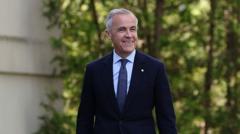In a bold move to address economic pressures heightened by ongoing trade tensions with the United States, Prime Minister Mark Carney has introduced a revamped cabinet, signalling a commitment to his extensive economic agenda. The newly appointed cabinet, comprised of 28 ministers and 10 secretaries of state, reflects a blend of seasoned politicians and fresh faces, aimed at tackling what Carney describes as a pivotal moment for Canada.
At the forefront of these changes is the appointment of Anita Anand as the new foreign minister, tasked with navigating the increasingly fraught relationship with the US, particularly in light of President Donald Trump’s ongoing remarks that challenge Canadian sovereignty. Following a recent meeting with Trump, Carney expressed hope for a new trade deal as he unveiled this reshuffled leadership team.
Dominic LeBlanc, a veteran MP, will now concentrate on Canada-US trade and addressing domestic trade barriers. Meanwhile, Maninder Sidhu has stepped into the position of international trade minister, taking the reins during these tumultuous economic times. Other notable changes include public safety being assigned to former justice minister Gary Anandasangaree, a role vital for overseeing border security issues central to current US tariffs.
The cabinet reshuffle has also seen the exclusion of notable figures such as Bill Blair and Jonathan Wilkinson, while Tim Hodgson, a relative newcomer elected earlier this year, assumes the natural resources portfolio. This infusion of new talent is accompanied by the retention of seasoned ministers like Francois-Philippe Champagne, who remains finance minister.
With Carney's cabinet embodying Canada’s diverse regional, linguistic, and ethnic composition, representation extends to the prairie provinces, reflecting the rising sentiments of alienation in the West. Notably, the cabinet continues the precedent of gender parity established by the previous administration. New roles feature leaders such as Gregor Robertson, overseeing housing, in response to critical affordability issues across the nation.
Critics, including Conservative leader Pierre Poilievre, have questioned Carney’s commitment to change, citing the retention of numerous Trudeau-era ministers. As Canada grapples with economic pressures stemming from its southern neighbor's trade policies, the newly formed cabinet aims to unite and advance a robust national agenda.
At the forefront of these changes is the appointment of Anita Anand as the new foreign minister, tasked with navigating the increasingly fraught relationship with the US, particularly in light of President Donald Trump’s ongoing remarks that challenge Canadian sovereignty. Following a recent meeting with Trump, Carney expressed hope for a new trade deal as he unveiled this reshuffled leadership team.
Dominic LeBlanc, a veteran MP, will now concentrate on Canada-US trade and addressing domestic trade barriers. Meanwhile, Maninder Sidhu has stepped into the position of international trade minister, taking the reins during these tumultuous economic times. Other notable changes include public safety being assigned to former justice minister Gary Anandasangaree, a role vital for overseeing border security issues central to current US tariffs.
The cabinet reshuffle has also seen the exclusion of notable figures such as Bill Blair and Jonathan Wilkinson, while Tim Hodgson, a relative newcomer elected earlier this year, assumes the natural resources portfolio. This infusion of new talent is accompanied by the retention of seasoned ministers like Francois-Philippe Champagne, who remains finance minister.
With Carney's cabinet embodying Canada’s diverse regional, linguistic, and ethnic composition, representation extends to the prairie provinces, reflecting the rising sentiments of alienation in the West. Notably, the cabinet continues the precedent of gender parity established by the previous administration. New roles feature leaders such as Gregor Robertson, overseeing housing, in response to critical affordability issues across the nation.
Critics, including Conservative leader Pierre Poilievre, have questioned Carney’s commitment to change, citing the retention of numerous Trudeau-era ministers. As Canada grapples with economic pressures stemming from its southern neighbor's trade policies, the newly formed cabinet aims to unite and advance a robust national agenda.


















